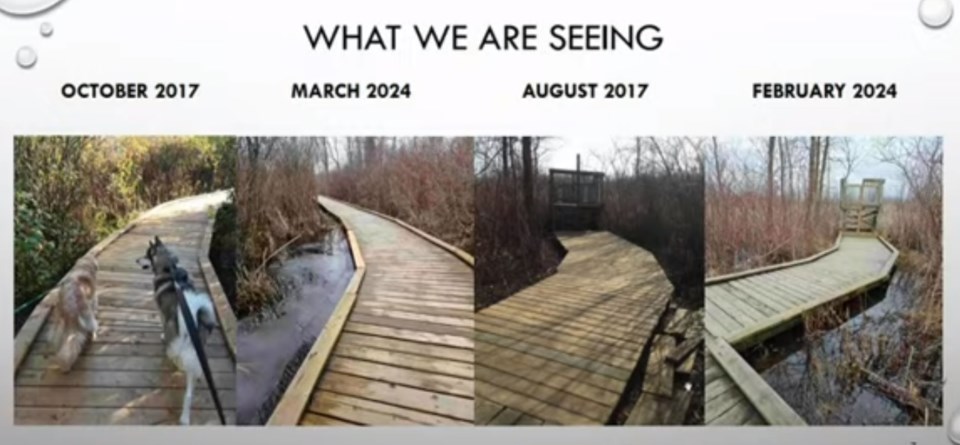The rising water levels of Cranberry Marsh have neighbours raising alarm bells for the Town of Collingwood to do something, and soon.
During council’s regular meeting on March 18, Heather McCleary and Nick Best presented council with their experiences living so close to the marsh, and the kinds of flooding they’ve experienced in that time.
McCleary, who lives on Woodland Court and is a past president of her condominium corporation, said she and others have been concerned about the “alarming speed” at which water levels in the area are rising.
The council chambers were packed with other residents with the same experiences.
“Mature trees are drowning and because of the high water level, they are not being replaced by younger ones or other appropriate vegetation,” McCleary said.
“If the situation is not remedied quickly, the residential developments that abut the Cranberry Marsh will be flooded as water has already pooled on their property,” she added.
Cranberry Marsh is located south of Highway 26, between Cranberry Trail East and West.
McCleary said more than 100 residents of the surrounding developments have been in contact with town officials over the years as flooding happens, and said town staff have been responsive to requests when called.

However, she said the patchwork solutions presented so far aren’t enough to solve the problem permanently.
“The problem seems to be gaining momentum,” she said.
McCleary showed multiple photos of the same areas at different times of year, over multiple years, to show the severity of the flooding.
She said as recently as two years ago residents could walk, snowshoe and snowmobile along the Cranberry Marsh trail – a feat impossible now. She said the Cranberry Marsh boardwalk has helped, but that now the water levels are getting close to the height of the boardwalk, too.
“In some places, the water levels are at the same level as the boardwalk,” she said.
Best speculated on possible causes of increasing water levels, specifically pointing to increased residential development in the area, an increase in vegetation and reed growth blocking water flows, and beaver dams popping up across the marsh.
The concern of existing residents is that new developments planned for the area will only make the water level issue exponentially worse.
The duo proposed some possible solutions to the problem, pointing to pond levelling and the creation of a wetland habitat used at the Beaver Hills Biosphere Reserve in Alta. which reduced flood risk, and potential collaboration with the Ministry of Natural Resources and Forestry and the Nottawasaga Valley Conservation Authority to come up with a permanent drainage solution.
“A solution is required now. We cannot wait for a two-year study and further two years to decide on how a future solution will be paid for and by whom,” said Best. “We are hopeful and confident that by all parties working collaboratively we can resolve these rising water level issues. We offer our help whenever and wherever necessary.”
At the end of the presentation, Coun. Christopher Baines put forward a notice of motion asking staff to investigate the issue and report back to council with possible solutions to remediate the water level in Cranberry Marsh, and collaborate with all stakeholder groups on long-term solutions.
The motion will be considered by councillors at a future council meeting.



